The Grange: Moorabbin
The site where the Moorabbin Police Station is currently located was once the focus of a bitter and long lasting argument in the Moorabbin Council and community. Before the police station was built the site was the location of a home, built by one of the district’s early settlers, that came be known as The Grange. By the 1970s the house was old and in need of maintenance but many people believed the house should be saved from demolition and converted into an arts and cultural centre and headquarters of an historical society. Others wanted the site redeveloped as the location of a new council administration building. Some were just happy if nothing were done, thereby avoiding a drain on ratepayer funds.
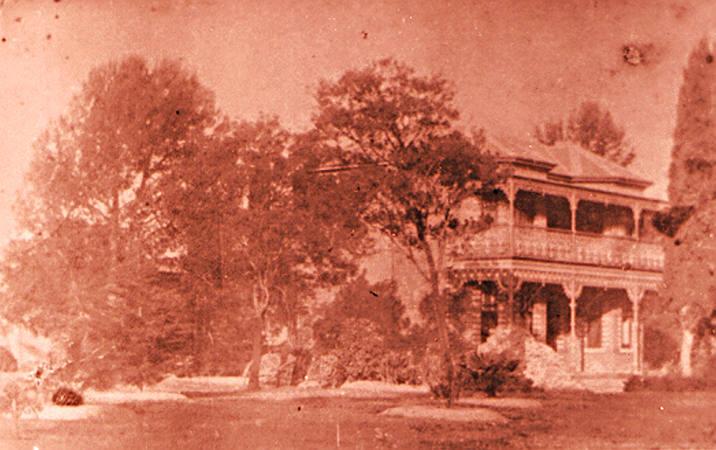
‘The Grange’ first named Baydon Hill by the Tuck family and later renamed ‘Hazeldene’. Courtesy Neil Follett.
It was Charles Tuck who built the brick two-storey residence on the site. Members of the Tuck family had been living in the district since the 1850s. Robert and Mary Tuck, the earliest local Tucks, were among the early settlers buried in the Beaumaris Cemetery. Charles was one of their sons who established himself in South Brighton as a blacksmith or farrier. In some documents he is referred to as a veterinary surgeon. He had an extensive knowledge and a lot of practical experience in treating diseases in horses. Because of this he was appointed an honorary agent of the Society for the Protection of Animals in 1882. [1] The house he built was first named Baydon Hill but in 1903 it was renamed Hazeldene. It gained the name The Grange in 1918. [2] In 1893 Charles died and was buried in the Cheltenham Pioneers Cemetery where a very substantial granite Gallic cross was erected over his grave.
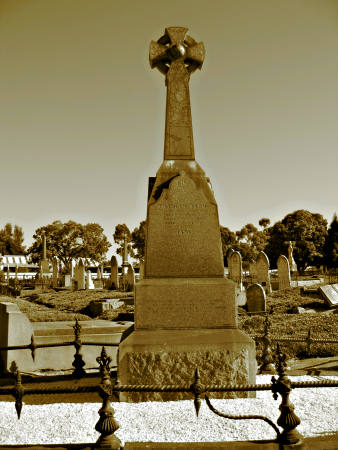
The grave of Charles Tuck in the Cheltenham Pioneers Cemetery, 2005.
In the early 1900s the property was 10 acres which extended from Point Nepean Road north east right down to South Road. It was owned by Mr Sampson, a retired English gentleman. He sold it to Harold James Healey, the father of seven children, in the 1920s. A Chinaman rented a section of land around the house for use as a market garden and he continued to work it for some time. But when Harold Healey’s sons grew up the Chinese gardener left and they worked the land as a nursery and did so for 42 years. During the Second World War the residence was used as the headquarters of the air raid wardens and later Sister Nicholls rented it as a rest home for elderly people. [3] In 1965 the property was sub-divided and some of the land was sold.
Keith, a son of Harold Healey, moved into the house with his family and had it remodelled to conform to a more modern style of living. A kitchen was added downstairs and a bathroom suite was constructed upstairs. The original front of the house was remodelled with the iron lace being removed from the balcony and dumped in some tip because it was ‘old fashioned’. [4]
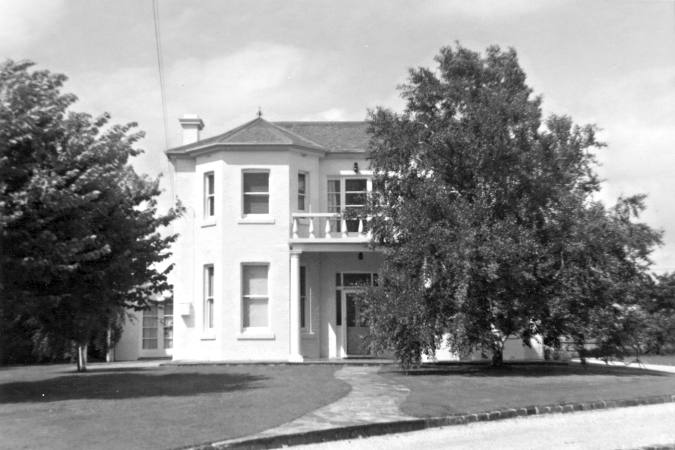
’The Grange’, c1980. Courtesy Moorabbin and District Historical Society.
Many companies viewed with interest the notion of investing in the property on which the house was built. However, it was the proposal of the Hammerson Trust Ltd in April 1964 that attracted community attention and conditional support from the local Chamber of Commerce. Cr Hodgson suggested that the Moorabbin Chamber of Commerce would support the rezoning of the Healey land to commercial usage provided the consolidation of the Moorabbin shopping centre was part of the plan. He claimed a separate shopping centre was not wanted. The Trust proposed building three big stores and twenty smaller shops set in seven hundred parking spaces to complement the existing shopping centre at Moorabbin. But it was not to be. A rival proposal by Myer for a £10 million development on twenty seven acres further south on the St John of God site at Cheltenham won Council support.[5] Two large developments in the one district were not considered commercially viable so the Grange proposal fell away.
It was almost ten years before any further action took place concerning the Healey land and residence. In June 1973 the Moorabbin Council announced that it had purchased The Grange and the two acres of land surrounding it from two Healey brothers. The cost was £255,000. Now began the discussion on how the property should be used. To facilitate a decision the council formed an advisory committee, made up of councillors, named the Culture and Arts Committee. The town clerk, Jim Waters, had already indicated that it was planned to move the Moorabbin branch of the municipal library there from its temporary quarters under the town hall. There was also the thought of building a small theatre complex, hopefully, it was suggested, with a financial subsidy from the Ministry for the Arts, and a museum. [6] Action was again delayed.
Two and a half years were to pass and the rumour was circulating that the councillors were in favour of knocking down The Grange. The Council was accused of discussing the future of the old house in closed meetings and some people rallied to the cause of protecting the building. Tom Sheehy, the historical research officer for the City of Moorabbin, reminded people that the house was the oldest building in Moorabbin and as such had an important place in local history. Moreover, he claimed that it was because of his advice that the council bought the property and warned the councillors that he had alerted the National Trust to the potential tragedy should the building be destroyed. [7]
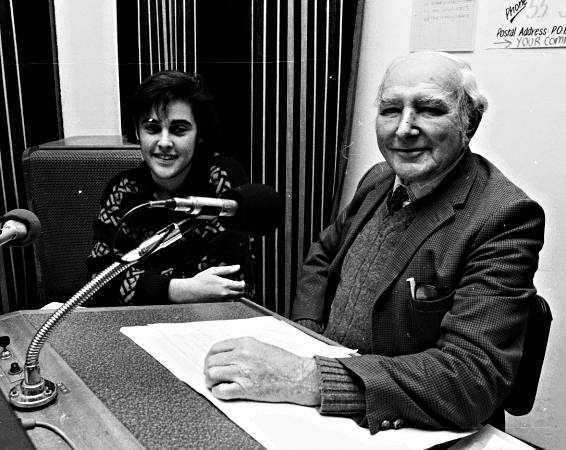
Moorabbin historian Tom Sheehy with Standard Newspapers journalist Gabby Trifiletti on the Southern Community Broadcasters 'Magic of History' program, 1986. Courtesy Leader Collection.
Clyde Killingsworth, a resident of Moorabbin, attended a meeting of the Moorabbin Council where he clashed with the mayor, Cr Don Bricker, and was warned to desist or be evicted from the meeting. He left on his own accord but spoke to a reporter from The Standard attacking the autocratic attitude of the mayor and the reactionary and dictatorial behaviour of the councillors. [8] Later he said, “It is a horrifying thought that Council could even consider destroying the last of the aged stately homes within the municipality because of the cost of a few thousand dollars when they liberally spend $70,000 on a heated swimming pool and $500,000 on a football pavilion and oval.” [9]
Earlier the secretary of the Southern Cross Theatre Group welcomed the proposal to build a theatre complex, pointing out that a venue was needed for productions by groups of players, singers and dancers. “There were twenty five amateur groups attempting to produce plays in Moorabbin but because of the lack of facilities they were forced to perform as far away as Frankston, Kew and Monash University,” she said. [10] Killingsworth as a compromise suggested that maintaining the house as well as building a theatre complex and administrative block was a possibility which could accommodate all views. This he was sure would meet with approval by the Moorabbin community. All that was needed was a creative designer who had the imagination to blend the old and the new in one complex. [11]
Cr Keith Duckmanton , the chairman of the Culture and Arts Committee, made it clear that his vote was for demolition. But he agreed that the Council had to decide what to put on The Grange site before it was pulled down. In his view the council had never given assurance that The Grange was to be preserved as an historic building. He said it was bought because of its close proximity to the town hall with the idea of using it for Council purposes and because it was a good buy. It would be a complete waste of money to update the building even on a temporary basis, Cr Duckmanton suggested. When the Council came to vote upon the issue only three councillors voted against the motion to demolish The Grange. [12] Cr Gerald Basterfield, one of the three, agreed that the back part of the building was not worth keeping but advocated that the front be maintained as a “sort of a frontispiece” to the new complex.
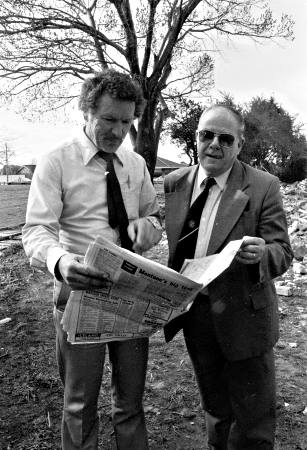
Cr Keith Duckmanton discusses the demolition of ‘The Grange’, 1983. Courtesy Leader Collection.
One of the arguments in favour of demolition was that the building had no historical value because of the additions and modifications inflicted upon it over time. A Standard News reporter, after inspecting the building, concluded that it was a house “with a heart that no longer beats.” [13] Although impressive from the outside the interior was of an old fashioned family home rather than a historical homestead. The kitchen with its modern gas stove and large amount of wooden bench space with laminex tops was large. It reflected the fashion of the 1940s with its red and white colour scheme. A drawing room had a few notice boards with historical information placed around the walls. There were historical relics in other rooms; a broken gramophone, dummies patched up with plaster of paris and old cupboards and tables. Upstairs two bedrooms were locked but the bathroom had watery rust stains trickling down the sides of the shower recess. The cellar was said to fill with water when it rained but on the occasion of this visit was quite dry, sandy and empty. [14]
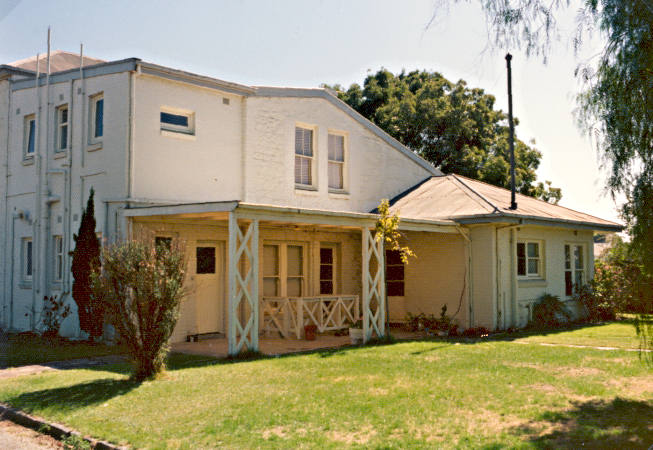
The rear of The Grange, c1980. Courtesy Moorabbin and District Historical Society.
A few months later vandals gained entry to the building and deliberately lit four separate fires which caused $5000 worth of damage. Front windows were smashed, the front door was kicked in and petrol was splashed around the walls and over the curtain drapes. The result of the fires was that the inside of the building was a charred, gutted mess. [15] Tom Sheehy disputed the financial estimate of the damage by the city engineer. He believed it was well in excess of $5000 as he had what he described as priceless relics of history stored in several rooms and all were destroyed by the fire.
In July 1978 the National Trust revised its earlier assessment on the historical value of the Grange from one of “no historical value” to one which said its “preservation was encouraged.” While acknowledging there had been numerous alterations and additions, including the removal of the front first floor balcony, the Trust said the main building was still largely intact. [16]
After some repairs were made to the building it was rented out to Mr and Mrs Deam as caretaker tenants at $58 per month. At least this action provided a reprieve for The Grange until the Council established a viable plan for the development of the site.
The Council decided to call for submissions on how the site should be developed as an arts and cultural precinct. In proposing this action Cr Don Bricker said it was time the people knew what Council wanted to do with this site. Commenting on the passage of time since the property was purchased from the Healey Brothers he said, “We’re racing forward like a bloody crayfish going backwards.” [17] A prize of $10,000 was to be paid to the individual or firm selected to develop the site.
Clyde Killingsworth, a leading advocate for the retention of The Grange was very disappointed on the Council’s action. Not only did he think the $10,000 was a complete waste of money, he thought the notion of an arts and cultural centre was a grandiose pipe dream that would never materialize. He said there was nothing positive to ensure that “the only real piece of history in the city of Moorabbin would stand in the future.” [18]
Four years later the Council called for tenders to bulldoze the Grange. “About time,” was Cr Duckmanton’s comment. The decision to demolish the building was made after the Council learned that it was costing $3600 per year to maintain. Of the two tenders received that of A W LcLeish & Co at $500 was accepted. By August 1983 The Grange was coming down after more than ten years of controversy since its purchase in 1972. However, what was to be done with the site had not been resolved. That was to take several more years of discussion.
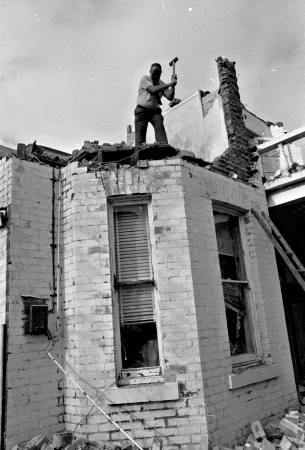
Cr Keith Duckmanton delivers a ‘Final Blow’ to ‘The Grange’ with a sledgehammer, 1983. Courtesy Leader Collection.
Footnotes
- Brighton Southern Cross, October 7, 1882.
- Moorabbin Standard News, July 26, 1978.
- Moorabbin Standard News, June 6, 1973.
- Moorabbin Standard News, June 1973.
- Moorabbin News, December 10, 1964.
- Moorabbin Standard News, June 6, 1973.
- Moorabbin Standard News, February 18, 1976.
- Moorabbin Standard News, May 5, 1976.
- Moorabbin Standard News, June 8, 1977.
- Moorabbin Standard News, May 19, 1976.
- Moorabbin Standard News, June 22, 1977.
- Cr Julie Cooper, Cr Gerald Basterfield, and Cr Frank LePage.
- Moorabbin Standard News, June 29, 1977.
- Moorabbin Standard News, June, 29, 1977.
- Moorabbin Standard News, September 14, 1977.
- Moorabbin Standard News, July 26, 1978.
- Moorabbin Standard News, June 20, 1979.
- Moorabbin Standard News, June 20, 1979.
